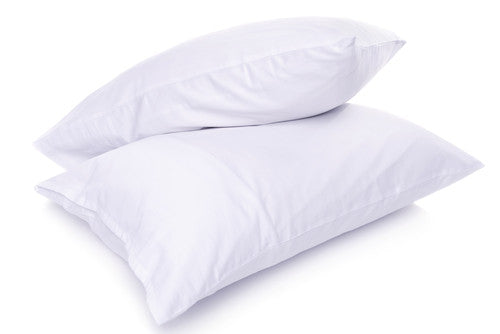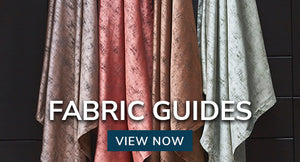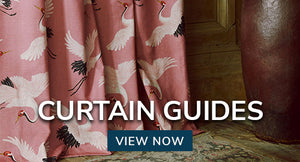Our complete bedding buying guide to pillows and duvets
There are two things that we give little thought to purchasing during the spring and summer months and that is duvets and pillows, duvets in particular. After all, we have little need for them. No doubt there are many of us who have trouble sleeping through the hot and humid nights of summer. Our sleep habits often involve enduring hours of restless tossing and turning, hot sweats which result in actually abandoning and throwing off sheets and duvets altogether and eventually getting up to open the windows in a futile attempt to conjure up even the slightest of cooling breezes from the still night air.

There is nothing worse than being too cold at night either and as the weather changes with the onset of the colder season and the nights draw in, we start turning our thoughts to all things warm and comforting as we subconsciously go into 'cosy-nesting' and 'semi-hibernation' mode and start 'wrapping ourselves up' to protect against the elements outside.
The continental quilt, or duvet as it is also known, has become common place in our homes today, despite only becoming popular as a household product, throughout the world, in the late 20th century. But how many of us actually give proper thought or consideration to what we're buying when purchasing quilts & duvets, or understand their proper purpose and function and the 'tog' ratings that classify them?
To help you understand all the different terms and definitions associated with quilts, duvets and all that good stuff, we have collated a brief history of and comprehensive bedding and duvet buying guide.
Duvet definition
So, lets make a start with our duvet buying guide – and what better way that to define what a duvet is.
Continental Quilt, Duvet or Eiderdown – A soft quilt usually filled with the down of the eider duck - eiderdown; bedding made of two layers of cloth filled with stuffing and stitched together, a soft flat bag filled with down, feathers, wool, silk or a synthetic alternative and protected with a removable duvet cover, analogous to a pillow and pillow cases; a bed covering, stuffed with down or a synthetic material and containing pockets of air, used as a bed cover in place of the top sheet and blankets, also called a duvet
Duvet History
When buying a duvet, you may want to understand a little about its history – so we’ve got your covered.
Quilts or duvets originated in rural Europe in the mid-18th century. An Englishman called Thomas Nugent, on a grand tour of Europe, was passing through Westphalia in Germany and reportedly observed with surprise: "There is one thing very particular to them, that they do not cover themselves with bed-clothes, but lay one feather-bed over, and another under. This is comfortable enough in winter, but how they can bear their feather-beds over them in summer, as is generally practised, I cannot conceive."
Typically before this point, particularly in colder parts of Europe such as the UK, the norm had been to dress a bed with sheets to provide comfort against the skin, on top of which blankets, throws and comforters such as eiderdowns, were layered to achieve a desirable level of warmth and insulation. Eiderdowns, now rarely used, were in effect an early form of the quilt, but were only used as a bed topper, not as an entire bed covering.
Early quilts were understandably filled with the down feathers of the eider duck (known for its usefulness as a thermal insulator) too, but were used as a complete bed covering to provide a lighter but equally effective replacement for heavy sheets, blankets and toppers.
The Modern Day Duvet
In our busy and hectic, modern-day lifestyles, the Continental Quilt (or Duvet as it is now more commonly known) is common place in our homes , as it reduces the complexity of making a bed, and in addition provides valuable health and hygiene benefits with regards to allergies and dust and fibre particles.
Laborious laundering duties are reduced as well, as the duvet itself goes inside a purpose made cover, usually made of cotton or a cotton blend such as poly-cotton, to aid comfort, function and durability. Heavy fabrics are not recommended for duvet covers as their dense weave prevents the thermal qualities of the quilt from being effective as an insulator.

The duvet cover is removed and laundered as often as the bottom sheet and pillow cases, or as often as preferred, but the duvet itself needs cleaning much less frequently, and depending on its contents, may require specialist dry cleaning rather than washing. A modern duvet may be filled with down or feathers of various quality and cost, silk, wool, cotton, or artificial fibres such as polyester/polyfibre batting.
Quilts labelled as washable are often too big to fit into a domestic washing machine so it is necessary to launder them at a laundrette in the bigger drums of the industrial machines. Follow your washing instructions carefully though, to avoid damaging your quilt.
Thermal Performance and "Tog" ratings
"Tog" is a measurement of thermal insulation commonly used in the textile industry to quantify the warmth rating and thermal efficiency of quilts or duvets. Manufacturers rate the performance of their duvets in togs to enable the purchaser to select a duvet appropriate to the season: the higher the tog rating, the warmer the duvet. Here's the technical bit: a "tog" is 0.1 m2K/W.
In other words, the thermal resistance in togs is equal to ten times the temperature difference (in °C) between the two surfaces of a material, when the flow of heat is equal to one watt per square metre. That may be a little confusing by as a consumer all you really need to know is that togs are measured in steps (units) of 1.5 and start at 4.5tog (lightweight quilts) and go up to 15 tog (extra warm quilts).
Depending on what you're after or where you live even, use the following as a guide: - 3.0 - 4.5 tog / Lightweight Summer Duvet - 7.0 - 10.5 tog / Spring/Autumn Weight Duvet - 12.0 - 13.5 tog / Winter Weight Duvet All Seasons Duvets - These are combined duvet sets usually consisting of two duvets; one of approximately 4.5 tog and one of approximately 9.0 tog.
These can be used individually, the lightweight (4.5 tog) one for summer and the medium (9.0 tog) one for spring/autumn, or the two can be used together, usually attached to each other with press studs or Velcro strips, to become a 13.5 tog winter duvet and as such, can be made to suit all seasons and climates.

Standard Sizes As regards sizes, duvets can be manufactured to any size, but are usually available in sizes which correspond to standard bed sizes with an allowance for overhang, as follows:
| Single duvet | 135x200cm (53 inches x 78 inches approx) | Single Mattress | 90x190cm (35 inches x 74 inches approx) |
| Double duvet | 200x200cm (78 inches x 78 inches approx) | Double Mattress | 135x190cm (53 inches x 74 inches approx) |
| King duvet | 230x220cm (90 inches x 86 inches approx) | King Size Mattress | 150x200cm (59 inches x 78inches approx) |
| Super King duvet | 260x220cm (102 inches x 86 inches approx) | Superking Size Mattress | 180x200cm (71 inches x 78 inches approx) |
| Emperor duvet | 290x235cm (114 inches x 92 inches approx) Bed Sizes can vary. | Emperor Size Mattress | 200x200cm, 213x200cm or 213x213cm |
| Pillows | 48x74cm (19 inches x 29 inches approx), 50x90cm (19 inches x 36 inches approx), 65x65cm (50cm x 100cm) |
So What's Right for You? What Duvet should you buy?
Quality & Standards - The perfect quilt should be lightweight yet warm. The better the quality of the filling and the outer fabric, the better the quality and the overall performance of the quilt and the lighter it will be. A quilt with a natural 100% cotton covering such as cotton cambric or batiste, both of which have a good thread count, will have a soft feel to the touch and the natural cotton fibres will facilitate and enhance the effectiveness of the thermal filling whether it is feather and down filled or fibre filled. Good quality poly-cotton mixes also make ideal outer cases for quilts and duvets.
Fillings and Content - Good quality fillings will achieve warmer tog ratings without adding weight to the duvet to achieve the desirable combination of lightweight and warm. Synthetic, polyester based fillings referred to as hollow fibre, thermofill or microfibre fillings, provide effective and affordable solutions for more budget end quilts, and achieve acceptable levels of quality and performance without the hi-end price tag.

The fillings used for luxury, high quality quilts and duvets are usually natural not manmade or synthetic. They normally consist of goose feather or duck down, or a mixture of the two, as both are known for their natural thermal and insulating properties (although down is actually a better insulator than feather to be accurate, as its ability to trap warmth is unbeatable). Feather and down duvets are not advisable as summer duvets unless they carry a very low tog rating as they are too warm.
Construction & Durability - Duvets are constructed in a number of ways and again the construction method reflects quality and performance. Budget end quilts with synthetic fillings often have channels in their construction within which the filling can move or fall to the bottom of the quilt, causing uneven coverage and creating cold spots, which results in poor performance. On better quality synthetic duvets, the filling is spread evenly and secured with intermittent stitching to keep the filling in place and therefore improve performance and longevity.

Natural fillings such as feathers and down, whilst easily plumped to refresh, are obviously susceptible to a lot more movement and as a result, duvets with down and feather fillings are constructed in a specific way, with a box stitched cassette system.
This is essentially a grid formed from lines of stitching, which are spaced at regular intervals across and down the duvet to form a series of squares, which act as pockets within which equally measured amounts of feather or down are contained. In this way the filling is kept in place evenly, making the insulation value consistent across the whole quilt and facilitating laundering and cleaning with much more ease.
Buying a duvet? - See what Terry's have on offer:
White Duvet 10.5 tog - This budget duvet will serve its purpose well enough without breaking the bank. The poly-cotton cover is filled with polyester and hollow fibres, making the quilt fully washable and it can be tumble dried too. It is a hygienic non-allergenic quilt, possibly suitable for a child's first quilt and go with their first childrens duvet cover. Also ideal for students, rental properties and B&B's. This excellent value for money duvet is available in Single, Double and King Sizes and in 10.5, 13.5 and 15tog weights.
Micro Fibre Duvet 10.5 tog - This is a fantastic quality microfibre budget range duvet. This duvet again has a poly-cotton cover, but is filled with microfibre. Microfibre is still as light as, but has slightly more volume than, standard hollow fibres. The duvet is washable, tumble dryer safe, hygienic and non-allergenic. Available in single, double and kingsize and in 10.5 and 13.5 tog ratings, this product is a good choice for first time buyers come home-makers.
Snuggledown Thermofill Duvet 10.5 tog - The Thermofill range is difficult to beat on quality and value. These Snuggledown duvets have a soft feel, 50% polyester, 50% cotton case, filled with siliconised, hollow polyester fibre filling. The filling is stitched intermittently to ensure the fibre is evenly distributed across the entire duvet. This effectively results in good performance without cold spots, giving this range considerably improved quality and longevity against budget range quilts. Each duvet is non-allergenic, washable at 40'c and is available in four sizes, from single to super king, and three tog ratings, plus an all-seasons combo. The range also boasts matching thermofill pillows.

Snuggledown Microfibre Duvet 10.5 tog These lovely Microfibre duvets are effectively the synthetic equivalent of a down duvet. They have a high grade 100% cotton case, which is filled with slick microfibers to give this duvet a lightweight, but much loftier feel, than other synthetic fills. As with the Thermofill duvets, the filling is intermittently stitched, producing a duvet with highly efficient, if not unbeatable performance. In terms of a good value product, it is difficult to beat the Thermofill range. However, the Microfibre is without doubt a step up in terms of quality and performance and whilst there is a noticeable difference in cost, there is undoubtedly a marked difference in the quality and performance, which is well worth the extra few pounds.
Snuggledown Goose Feather & Down Duvet 10.5 tog - These luxury quilts employ nature's natural insulators - feather and down - to achieve the most efficient, effective and super snugly duvets you can imagine. This sumptuously thick duvet has a cotton cambric casing, filled with a combination of weighty goose feathers and lightweight down, which are trapped in cassette stitched chambers to keep them evenly distributed across the duvet. The construction of this quilt means that despite its natural content, it is fully washable. And for an extra comfortable night's sleep, there are luxuriously indulgent matching feather pillows available too.
Snuggledown Duck Down Duvet 10.5 tog - Down is lighter than feathers, so this amazing duck down duvet offers superior warmth and luxury, combined with the lightest, fluffiest and most re-plump-able filling imaginable. Down in its natural environment is designed to keep birds warm, so understandably, in terms of its thermal qualities it is unbeatable! Some would say that with luxury comes expense and these quality quilts do carry a higher price tag but, whilst other products may provide efficiency and affordability, the luxury and lightweight feel of down products is well worth the outlay, so go ahead and indulge. If you're going to have a 'duvet day', it might as well be a luxury one!
Pillows
A pillow is very much a matter of personal taste, but considering what type of sleeper you are, is a good place to start if you're in the market for new pillows. There are various options available these days, as manufacturers have taken steps to consider the different sleeping habits of slumbering individuals to aid a restful and healthy night's sleep, so there is something to suit everyone. As with quilts and duvets, natural and synthetic fillings are available and again quality and durability are governed by what's inside the product.

In terms of quality with synthetic fillings the fibres are key in terms of longevity. Polyester fibre and hollow fibre fillings provide a cheaper alternative to feather pillows but vary in quality and effectiveness. Budget pillows make use of carded fibres - effectively blocks of fibre - which can collapse after only a few months and lose the ability to be plumped, but can be cost effective if you need to change your pillows on a frequent or regular basis.
For something with more longevity and the ability to be re-plumped again and again, blown fibres provide a solution. This basically means that the fibres are blown into the pillow casings trapping lots of air between the fibres to give a volumising effect, rather than the compressed effect of block fibres. The blown fibre is also much softer in feel but gives much better support.

For the ultimate luxury and comfort with pillows, however, you can't beat feather! Feather or feather and down mix pillows are available in differing densities from soft to firm and provide a wonderfully luxurious comfort with the added bonus that they can be plumped again and again and again. Specialised pillows such as memory foam to help alleviate back and neck problems and washable pillows to help to reduce allergy and asthmatic issues are also popular choices these days and catered for by most pillows manufacturers in their ranges.
Standard Sizes - Cushions are available in varying sizes starting from tiny children's starter pillows, up to extra wide pillows to comfortably accommodate the generous width of Super King and Emperor sized beds. The post popular size, however, which sits comfortably on most single, double and king size beds, is the standard pillow size of, 19 x 29 inches or 48 x 74cms. The table below shows the larger Super King and Emperor bed pillow sizes.
| Pillows | 48x74cm (19 inches x 29 inches approx), 50x90cm (19 inches x 36 inches approx), 65x65cm (50cm x 100cm) |
So What Type of Sleeper Are You ...
Front Sleepers - Soft pillows cater for those who sleep with a flat pillow and therefore, probably on their fronts. A soft, flat, pillow will provide the correct neck support for a front sleeper for a more comfortable night's sleep.
Back Sleepers - Medium density pillows have slightly more filling to offer a little more support and cater more for those who sleep on their backs, or those that may change positions frequently as they sleep.
Side Sleepers - Firm pillows are much fuller pillows. More filling, be it synthetic or natural, is packed in to the pillow casing and these cater for those who sleep mainly on their sides and are preferred by some back sleepers too.

Shopping for Pillows? - See what Terry's Have Got:
Snuggledown Thermofill Lite Medium Pillow - If you want extra pillows just to dress the bed with, to showcase r best pillowcases, cheep and cheerful options for your rented accommodation, or simply spares to keep for visitors, then any of our budget range cushions will fit the bill - from as little as £2.90 per pillow.
Snuggledown Front Sleeper Pillow - We all have different sleeping habits, so if you have a preferred sleeping position then our range of front, side and back sleeper pillows will be ideal for you and the rest of your family
Snuggledown Memory Microfibre Pillow - Memory foam and microfibre pillows use heat sensitive technology, that responds to the warmth and weight of your head and neck, to create a pillow that moulds to your contours, whilst still allowing air to circulate around your head and neck, and ultimately providing all the necessary and desired support that you need for a restful night's sleep. Memory pillows are favoured by many people who suffer with back and neck problems as they can reduce pressure on the spine and provide pain relief.
Snuggledown Goose Feather and Down Pillow - Luxury doesn't always have to come at a price and our range of luxury pillows is testament to that and whether you're after natural or synthetic, there's something here to suit.



























































